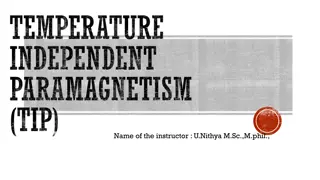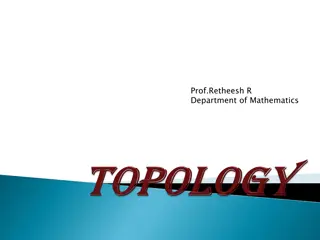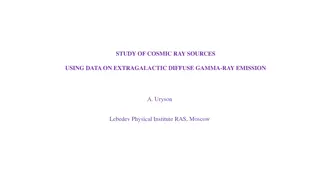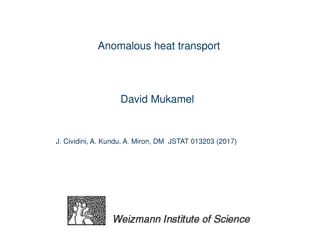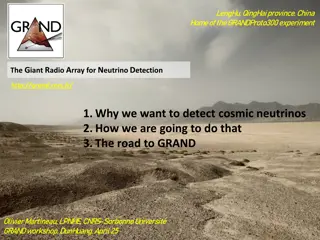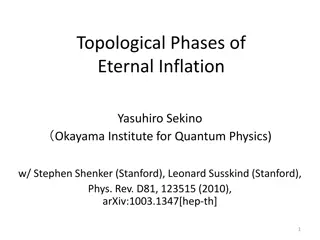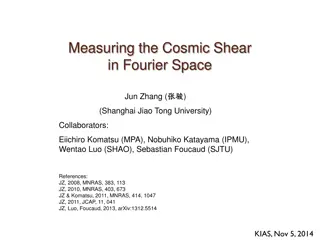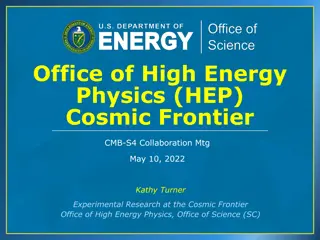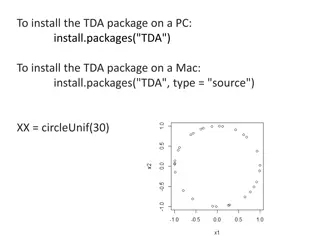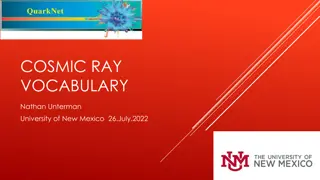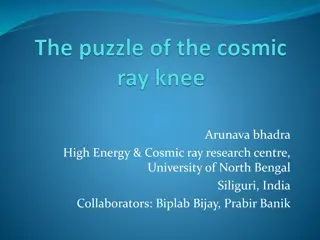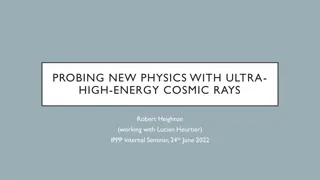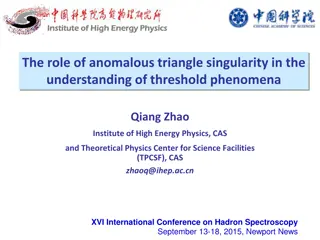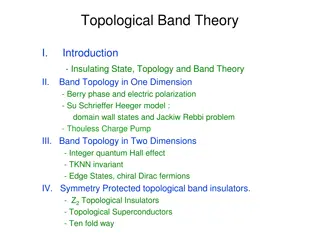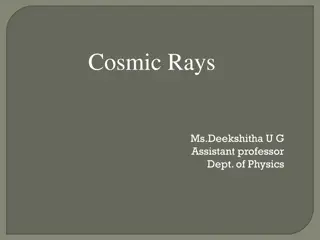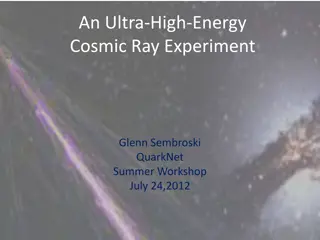Topological Quintessence: Anomalous Cosmic Anisotropies and Dark Flow Directions
The consistency of Cold Dark Matter (CDM) with observational data has improved over the past decade, but tensions remain with various cosmic anomalies such as preferred anisotropy axes and dark flow directions. Topological Quintessence, a physical mechanism proposed by L. Perivolaropoulos and collaborators, suggests a Hubble-scale dark energy inhomogeneity that can explain these anomalies. An off-center observer in a spherical dark energy environment and non-minimal coupling of scalar fields to electromagnetism are key aspects of the proposed model. An investigation into the alignment and magnitude of cosmic anisotropy axes reveals intriguing alignments of dark flow directions, prompting questions about the underlying physical mechanisms governing these cosmic phenomena.
Download Presentation

Please find below an Image/Link to download the presentation.
The content on the website is provided AS IS for your information and personal use only. It may not be sold, licensed, or shared on other websites without obtaining consent from the author.If you encounter any issues during the download, it is possible that the publisher has removed the file from their server.
You are allowed to download the files provided on this website for personal or commercial use, subject to the condition that they are used lawfully. All files are the property of their respective owners.
The content on the website is provided AS IS for your information and personal use only. It may not be sold, licensed, or shared on other websites without obtaining consent from the author.
E N D
Presentation Transcript
Open page Topological Quintessence: L. Perivolaropoulos http://leandros.physics.uoi.gr Department of Physics University of Ioannina Collaborators: J. Bueno-Sanchez (Madrid) J. Grande (Barcelona) A. Mariano (LaPlata, Argentina) N. Platis (Ioannina) 1
Main Points The consistency level of CDM with geometrical data probes has been increasing with time during the last decade. There are some puzzling tensions between CDM predictions and dynamical data probes (CMB power asymmetry, bulk flows, alignment and magnitude of low CMB multipoles, Fine Structure Constant Dipole, Dark energy Dipole) Most of these puzzles are related to the existence of preferred anisotropy axes which appear to be surprisingly close to each other! A simple mechanism that can give rise to a cosmological preferred axis is based on an off-center observer in a spherical dark energy inhomogeneity. Topological Quintessence is a physical mechanism that can give rise to a Hubble scale dark energy inhomogeneity. A weak non-minimal coupling of the scalar field to electromagnetism can naturally lead to aligned dipole with a dark energy dipole. 2
Cosmic Anisotropy Axes Dark Flow Direction (3 ) (407 81km/sec at r<107Mpc towards (l,b)=(287o 9o,8o 6o), Watkins et. al. MNRAS (2009) (COMPOSITE dataset) WMAP7 CMB Map Maximum Temperature Asymmetry (1.5 ) (A. Mariano, LP, arXiv:1211.5915 Phys. Rev. D. 87, 043511 (2013)) l= 320o, b=-11o larger Dark Energy Dipole (2 ) A. Mariano, LP, , Phys.Rev. D86 (2012) 083517. Dipole (4 ) Webb et. al. , Phys. Rev. Lett. 107, 191101 (2011) l= 309o, b=-15o Q1: How anomalous is this coincidence? Q2: Is there a physical model that can predict this coincidence 3
Cosmic Anisotropy Axes Dark Flow Direction (3 ) (800 200km/sec at r<600Mpc towards (l,b)=(296o 13o,14o 13o), Kashlinsky et. al. ApJL (2010) (kSZ effct on CMB) WMAP7 CMB Map Maximum Temperature Asymmetry (1.5 ) (A. Mariano, LP, arXiv:1211.5915 Phys. Rev. D. 87, 043511 (2013)) l= 320o, b=-11o larger Dark Energy Dipole (2 ) A. Mariano, LP, , Phys.Rev. D86 (2012) 083517. Dipole (4 ) Webb et. al. , Phys. Rev. Lett. 107, 191101 (2011) l= 309o, b=-15o Q1: How anomalous is this coincidence? Q2: Is there a physical model that can predict this coincidence 4
Cosmic Anisotropy Axes Dark Flow Direction (2 ) (249 76km/sec at r<190Mpc towards (l,b)=(319o 18o,7o 14o), (245 SneIa) Turnbull et. al. Mon.Not.Roy.Astron.Soc. 420 (2012) WMAP7 CMB Map Maximum Temperature Asymmetry (1.5 ) (A. Mariano, LP, arXiv:1211.5915 Phys. Rev. D. 87, 043511 (2013)) Dark Energy Dipole (2 ) A. Mariano, LP, , Phys.Rev. D86 (2012) 083517. Dipole (4 ) Webb et. al. , Phys. Rev. Lett. 107, 191101 (2011) Q1: How anomalous is this coincidence? Q2: Is there a physical model that can predict this coincidence 5
Basic Issue Q: What is the probability to produce the observed combination of just the two dipoles in a homogeneous-isotropic cosmological model? A: Monte Carlo Analysis: The probability that the combined quasar absorber ( dipole) and SnIa data (dark energy dipole) are obtained in the context of a homogeneous and isotropic cosmology is less than one part in 106. A. Mariano, LP, , Phys.Rev. D86 (2012) 083517. 6
Possible Cases 1. The data are flawed due to systematics. 2. The data are unlikely statistical fluctuations in the context of isotropic CDM. 3. The data are correct and a new theoretical model is needed. 7
Inhomogeneous Dark Energy: Why Consider? Standard Model ( CDM): 1. Homogeneous - Isotropic Dark and Baryonic Matter. Coincidence Problem: Why Now? Time Dependent Dark Energy 2. Homogeneous-Isotropic-Constant Dark Energy (Cosmological Constant) Alternatively: Why Here? Inhomogeneous Dark Energy 3. General Relativity Consider Because: 1. New generic generalization of CDM (breaks homogeneity of dark energy). Includes CDM as special case. 2. Natural emergence of preferred axis (off center observers) 3. Well defined physical mechanism (topological quintessence with Hubble scale global monopoles). J. Grande, L.P., Phys. Rev. D 84, 023514 (2011). J. B. Sanchez, LP, Phys.Rev. D84 (2011) 123516 Similar mechanism to Topological Inflation: A. Vilenkin Phys.Rev.Lett. 72 (1994) 3137-3140 8
Topological Quintessence Global Monopole with Hubble scale Core = = 0 = ( ) V General Metric with Spherical Symmetry: 2 S Energy Momentum Tensor: J. B. Sanchez, LP, Phys.Rev. D84 (2011) 123516 9
Model Parameters J. B. Sanchez, LP, , Phys.Rev. D84 (2011) 123516 Monopole Core Scale: Potential Energy Density at the Core: Approximate Cosmic Evolution at the Core: Approximate Cosmic Evolution away from the Core: Physical Requirements: ( ) 0 0 in H t 1 1 H Cosmological Scale Core ( ) 0 Core Density similar as present matter density matt core 10
Global Monopole Configuration Global Monopole: Field Direction in Space and Energy Density Variation of expansion rate due to dark energy density variation Variation of ? Off-center Observer 11
Extended Topological Quintessence A. Mariano, LP, , Phys.Rev. D86 (2012) 083517. Non-minimally coupled scalar field Global Monopole Configuration: Fine Structure Constant: Fine Structure Constant Spatial Variation: 12
Possible Origin of the Alignment Global Monopole: Field Direction in Space and Energy Density Variation of due to field variation Great Repulser Variation of expansion rate due to dark energy density variation Off-center Observer 13
Full Dynamical Equations Energy-Momentum Conservation Initial-Boundary Conditions Static Monopole Profile ( =f(r) ) Homogeneous, Flat Matter Dominated (A=B=1) 14
Energy Densities 1. Monopole energy density slowly shrinks and dominates at late times in the core. 2. Matter develops underdensity at the core. 15
Scale Factors Accelerating Expansion at the core. =0.6 Mpl =0.1 Mpl r=5 r=0.5 =0.6 Mpl r=0 =0.1 Mpl 16
Approximate Toy Model Energy Momentum: 0 LTB Metric: Geodesics: Luminosity Distance: J. Grande, L.P., Phys. Rev. D 84, ( ) 2 0, r 023514 (2011). in 17
Constraints for On Center Observer 2 541 Union2 data: 18
Dilatonic Defects Abelian Higgs Model: Nielsen-Olesen ansatz: Dilatonic Abelian Higgs Model: For q>0 the scalar field effective mass at the core decreases and the vortex thickness increases. It also becomes favorable to decrease u . 19
Embedded Dilatonic Defects: Improved Stability Dilatonic Semilocal Model: Perturbed Fields: Perturbed Energy: Energy Perturbation: 20
Embedded Dilatonic Defects: Improved Stability Energy Perturbation: Stability Improves for larger q For q>0 the dilatonic term favors zero field f and perturbation g at the core. 21
Stability Parameter Sector Instability Stability LP, N. Platis , Phys. Rev. D 88, 065017 (2013) 22
Summary Early hints for deviation from the cosmological principle and statistical isotropy are being accumulated. This appears to be one of the most likely directions which may lead to new fundamental physics in the coming years. A simple mechanism that can give rise to a cosmological preferred axis is based on an off-center observer in a spherical energy dark energy inhomogeneity. Topological Quintessence constitutes a physical mechanism to produce Hubble scale dark energy inhomogeneities. Such a mechanism can also give rise to a Dark Energy Dipole, Large Scale Velocity Flows, Fine Structure Constant Dipole and a CMB Temperature Asymmetry. Other interesting effects may occur (quasar polarization alignment etc). 23
Monte Carlo Probability to obtain as large (or larger) dipole magnitudes with the observed alignment in an isotropic cosmological model: The fraction of isotropic Monte Carlo Keck+VLT datasets that can reproduce the obverved dipole magnitude is less than 0.01% 0.01% Monte-Carlo of Isotropic quasar absorber datasets (quasar positions fixed) 0.01% x 1% = 0.0001% The fraction of isotropic Monte Carlo Union2 datasets that can reproduce the obverved dipole magnitude and the observed alignment with Keck+VLT dipole is less than 1% 1% 24 Monte-Carlo of Isotropic SnIa Uniot2 datasets (SnIa positions fixed)
Simplest Model: Lematre Tolman Bondi Local spherical underdensity of matter (Void), no dark energy = 1 M out ( ) z ( ) z H H 0r in out 0.2 M in Apparent Acceleration Central Observer ( ) z H ( ) z H in out Faster expansion rate at low redshifts (local space equivalent to recent times) 25
Shifted Observer: Preferred Direction Local spherical underdensity of matter (Void) = 1 M out Preferred Direction 0r 0.2 M in Observer obs r ( ) z H ( ) z H in out Faster expansion rate at low redshifts (local space equivalent to recent times) 26


